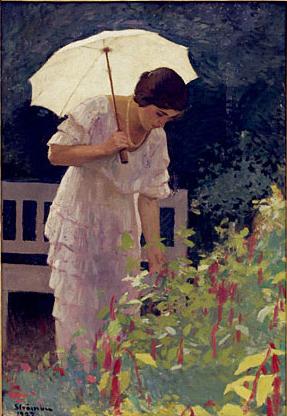Though I don't consider myself anything close to an expert, I do feel like I know more about 1920's fashion than any other time in history (perhaps with the exception of the Regency Era). It's been a 20's filled year for me, and for lots of other people as well. Aside from my own work both as a costume designer and an actor on various 20's projects,
The Artist, a film done in the style of silent movies, won the Academy Award for Best Picture, and this spring, the runways were filled with art deco-inspired designs.
So why this fascination with the 1920's? Despite the fact that the fashion is nearly 100 years old, flapper styles still reflect change, and the fresh novelty of new freedoms. Women had the right to vote, the world was on the other end of the biggest war they had ever seen, and the modern age had begun. Cue several hundred references to
Thoroughly Modern Millie.
You've probably noticed that my Decade Wednesday posts up to this point have been very formulaic. Take a look at the skirts, bodice, sleeves, textiles, and hairstyles. Note the differences between day and evening wear. But now that the modern era of fashion has begun, it's harder to do that. Women began to wear more suits and separates as they entered the workplace in droves. There was more variety in fashion than ever before, ranging from feminine, lacy dresses that were reminiscent of pre-war styles to sharp edges, bold colors, and scandalously short skirts.
Perhaps the most recognizable trait of 1920's clothing is the long, loose, straight lines that came after the tight corseting women had known their whole lives.
Second to that are the new, shorter skirts.
Evening dresses on the whole had the same sleeveless, moderately low neckline and mid-length skirts (although some high fashion couturiers played with lengths and sleeves).
Though the long, straight silhouette remained the same for both day and night (with a few notable fuller-skirted exceptions called
robes de style,
seen here), day wear had the addition of sleeves and collars, both for suits and suit-like dresses.
If a dress could be said to have any waist at all, it was very low, well below the hips.
This was all to enhance the new idea of womanly beauty: emulating men as much as possible. That's not to say that women suddenly took to cross dressing, but straight lines that minimized curves and short haircuts were very much in fashion. Coats did this as well as garments, effectively hiding the wearer under folds of warm, bulky cloth.
Though a boyish silhouette was popular, garments themselves were far from masculine. After a brief hiatus during the first World War, lace, floral accents, furs, bows, and feathers were back in full force. Oh, and did I mention beads? Everything a woman wore in the evening from gowns to headpieces were dripping in beads. And it was glorious.
Chiffon was a popular fabric for evening wear, and it moved beautifully with the lively new dances of the time.
By the 1920's, bobbed hair was widely accepted. Two versions of the bob existed, a very sleek, mature look, sometimes with bangs, and a curlier, more youthful style, often accomplished with a technique called a finger wave.
Hats were very fitted over the head and very close to the face, forming the cloche look that's iconic of the 1920's and 30's. I once read that hats were meant to be worn very low on the forehead, so that the only way a woman could see would be to tilt her head up and look down her nose.
By the end of the decade, longer skirts were coming back into fashion. To ease the world back into long skirts after going short for nearly an entire decade, designers used tiers to break up the visual line and trick the eye. (Thanks, Wiki)
This image foreshadows what we'll see next week; a return to feminine cuts and simpler styles. In my mind, I've always associated the 1930's with the 1920's. It will be interesting to see how much they really differ. Cheerio until then.


















No comments:
Post a Comment
,mmmmmmmmmmmmmmmmmmmmmmmmmmmmmmmmmmmmmmmmmmmmmmmmmmmmmmmmmmmmmmmmmmmmmmmmmmmmmmmmmmmmmmmmmmmmmmmmmmmmmmmmmmmmmmmmmmmmmmmm'aaaaaaaaaaaakAAAQA
I was going to type something clever, but my cat provided this triumph of literature. Thank you for commenting! Just keep it clean, on-topic, and respectful.